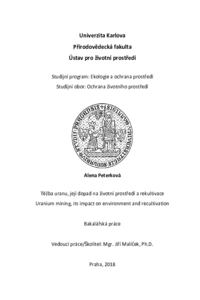Těžba uranu, její dopad na životní prostředí a rekultivace
Uranium mining, its impact on environment and recultivation
bachelor thesis (DEFENDED)

View/
Permanent link
http://hdl.handle.net/20.500.11956/98714Identifiers
Study Information System: 198469
CU Caralogue: 990021908560106986
Collections
- Kvalifikační práce [20889]
Author
Advisor
Consultant
Reif, Jiří
Referee
Frouz, Jan
Faculty / Institute
Faculty of Science
Discipline
Environmental Protection
Department
Department of Botany
Date of defense
7. 6. 2018
Publisher
Univerzita Karlova, Přírodovědecká fakultaLanguage
Czech
Grade
Good
Keywords (Czech)
biodiverzita, ekologická obnova, haldy, kontaminaceKeywords (English)
biodiversity, ecological restoration, heaps, contaminationČeská republika v minulosti patřila mezi významná území z hlediska těžby nerostných surovin. V období po druhé světové válce se stala velmi významným dobyvatelem uranové rudy, na kterou mnohonásobně vzrostla celosvětová poptávka díky rozvoji jaderné energetiky a masivní produkci nukleárních zbraní. V období osmdesátých let minulého století však zájem o uran poklesl a v devadesátých letech 20. století byly již téměř všechny uranové doly na našem území uzavřeny. Posledním místem těžby uranu byl důl Rožná, ve kterém bylo těženo až do roku 2017. V současné době probíhají na lokalitách rekultivační práce. Naplánování rekultivace pro dané území není však vždy jednoduchou záležitostí. Musí být brán v potaz způsob těžby, který byl na daném území prováděn, podloží, vzdálenost obydlí, podzemní vody, fauna a flóra okolí apod. Často jsou rekultivace prováděny nesprávným způsobem, a tím není dostatečně využit výjimečný potenciál biotopů zde vzniklých. Lidé mají tendence do obnovy krajiny silně zasahovat, jak už dodáváním živin, tak i vysazováním rostlinných druhů, a tím vytvářet intenzivní hospodářskou krajinu. Často si ovšem neuvědomují, že těžbou byla na lokalitě způsobena výrazná změna abiotických podmínek. Nově vzniklá stanoviště byla v mnohých případech osídlena vzácnými a ohroženými organismy, které jsou...
In past, the Czech Republic was one of the most important areas for mineral resources mining. In the period after the Second World War, the country was a very important conqueror of the uranium ore, thanks to a massive production of nuclear energy and nuclear weapons. However, in the 1980s, the interest in uranium declined and in the 1990s almost all of the uranium mines in the country were closed. Rožná was the last place of uranium mining, but it was closed in 2017. Nowadays, there are reclamation works in these mining places. Planning of a reclamation for is not always simply. It is necessary to think about the account of the method of extraction, which was used in the territory, the subsoil, distance from dwellings, underground water, fauna and flora of the surrounding nature etc. The land reclamations are often done in the wrong way and therefore, the extraordinary potential of the landscape is not exploited. People have a strong tendency to interfere this landscape, for example by supplying nutrients for creating of an intensive agricultural landscape. They often do not realize that the mining caused a change of abiotic conditions. The newly created habitats are often inhabited by rare and endangered organisms, living in early succession stages and missing in the surrounding landscape....
